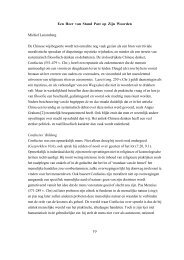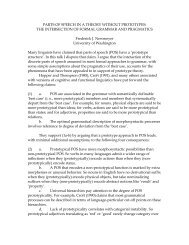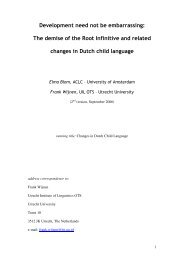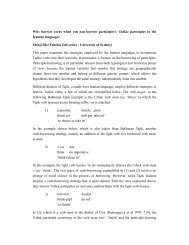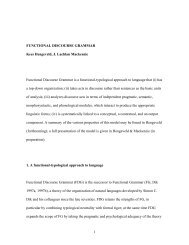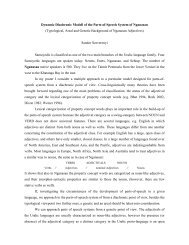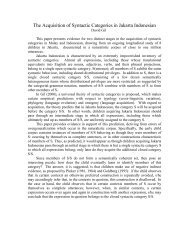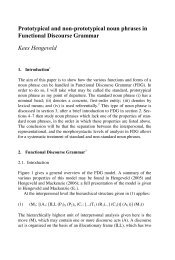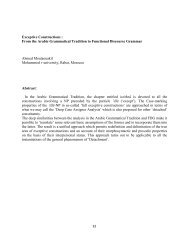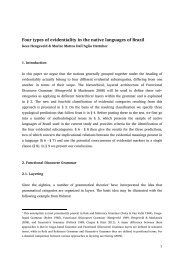The argument structure of deverbal nouns in Brazilian Portuguese
The argument structure of deverbal nouns in Brazilian Portuguese
The argument structure of deverbal nouns in Brazilian Portuguese
You also want an ePaper? Increase the reach of your titles
YUMPU automatically turns print PDFs into web optimized ePapers that Google loves.
d-a m<strong>in</strong>h-a mão... e est-a idéia de cri-ação<br />
<strong>of</strong>-the.F my-F hand… and this-F idea <strong>of</strong> create-NMLZ<br />
é que a<strong>in</strong>da ( ) é represent-ação... (EF-SP-405)<br />
be.IND.PRS.3SG that still ( ) be.IND.PRS.3SG represent-NMLZ<br />
‘to create a person... or to create an image is more or less the same th<strong>in</strong>g... <strong>in</strong> the sense that we<br />
are creat<strong>in</strong>g a new th<strong>in</strong>g... from noth<strong>in</strong>g... I had noth<strong>in</strong>g here before and now I have the image <strong>of</strong><br />
my hand ... and it is this idea <strong>of</strong> creation that still ( ) is representation...’<br />
<strong>The</strong> underl<strong>in</strong>ed <strong>nouns</strong> constitute a referential cha<strong>in</strong> based only on a common<br />
stem, irrespective <strong>of</strong> its category (verb or noun). This textual function seems to<br />
<strong>in</strong>dicate that <strong>deverbal</strong> <strong>nouns</strong> can preserve the verbal nature <strong>of</strong> the <strong>in</strong>put predicate<br />
partially, which justifies represent<strong>in</strong>g them <strong>in</strong> two layers at the Structural Level.<br />
<strong>The</strong> same text relationship and, therefore, the same morphosyntactic<br />
representation may be applied to adjectives represent<strong>in</strong>g <strong>argument</strong>s <strong>in</strong> the valency<br />
<strong>structure</strong> <strong>of</strong> <strong>deverbal</strong> <strong>nouns</strong>, as it can be seen <strong>in</strong> (55) and (13), repeated here as (56)<br />
for convenience.<br />
(55) Nós v-amos começ-ar pel-a Pré-História...[...] a a<br />
we go.AUX-IND.PRS.1PL start-INF by-the.F pre-history… […]<br />
a arte... n-o período paleolítico [...] a-s:: manifest-açõe-s<br />
the.F art… <strong>in</strong>-the.M period paleolithic […] the.F-PL:: manifest-NMLZ-PL<br />
artístic-a-s começ-aram a aparec-er<br />
artistic-F-PL start-IND.PRF.3PL to appear-INF<br />
n-o paleolítico superior (EF-SP-405)<br />
<strong>in</strong>-the.M paleolithic upper<br />
‘we are go<strong>in</strong>g to start from pre-history...[...] the art... <strong>in</strong> the paleolithic period [... ]:: artistic<br />
manifestations started to appear <strong>in</strong> the upper paleolithic period’<br />
(56) tod-a a evolu-ção human-a... não deix-a<br />
every-F the.F evolve-NMLZ human-F not let-IND.PRS.3SG<br />
de s-er exatamente a evolu-ção d-o<br />
<strong>of</strong> be-INF exactly the.F evolve-NMLZ <strong>of</strong>-the.M<br />
domíni-o que o homem t-em sobre<br />
control-NMLZ that the.M man have-IND.PRS.3SG over<br />
a natureza... (EF-SP-405)<br />
the.F nature<br />
‘every human evolution... is simply no more than the evolution <strong>of</strong> the control man has over<br />
the nature...’<br />
<strong>The</strong> expression <strong>of</strong> the first <strong>argument</strong> <strong>in</strong> the form <strong>of</strong> an adjective represents a<br />
cohesion relation between a preced<strong>in</strong>g noun <strong>in</strong> (55) and a subsequent noun <strong>in</strong> (56); <strong>in</strong><br />
addition to this k<strong>in</strong>d <strong>of</strong> textual recover<strong>in</strong>g, Keizer (2004b) mentions other k<strong>in</strong>ds <strong>of</strong><br />
resumption, illustrated <strong>in</strong> (57):<br />
(57) In Paris Franc<strong>in</strong>e Stock exam<strong>in</strong>es the th<strong>in</strong>k<strong>in</strong>g beh<strong>in</strong>d the last m<strong>in</strong>ute French <strong>in</strong>itiative what they<br />
hope do ga<strong>in</strong> from it. (Keizer 2004b: 12).<br />
30




